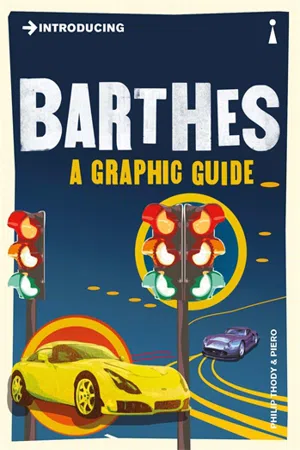
- 176 pages
- English
- ePUB (mobile friendly)
- Available on iOS & Android
About This Book
INTRODUCING guide to the cult author, semiologist and analyzer of advertising, Roland Barthes. Roland Barthes is best known as a semiologist, a student of the science of signs. This sees human beings primarily as communicating animals, and looks at the way they use language, clothes, gestures, hair styles, visual images, shapes and colour to convey to one another their tastes, their emotions, their ideal self-image and the values of their society. Introducing Barthes brilliantly elucidates Barthes' application of these ideas to literature, popular culture, clothes and fashion, and explains why his thinking in this area made him a key figure in the structuralist movement of the 1960s. It goes on to describe how his later insistence on pleasure, the delights of sexual non-conformity, and the freedom of the reader to interpret literary texts in the light of ideologies such as existentialism, Marxism and Freudianism, as well as structuralism itself, continues to make him one of the most dynamic and challenging of modern writers. This is the perfect companion volume to Introducing Semiotics.
Frequently asked questions
Information
“I Have a Question to Ask ...”

Mythologies

THEY ARE SOCIAL CONSTRUCTS, GIVEN TO US BY OUR RELATIONSHIP WITH OTHER HUMAN BEINGS, AND MEANINGFUL ONLY IN THE SOCIETY IN WHICH WE HAPPEN TO LIVE.

AND WOULD NOT HAVE BEEN APPOINTED IN THE FIRST PLACE IF HE HAD BEEN A ROMAN CATHOLIC!
“It’s Natural”

BUT WHAT WE EAT, WHEN WE SLEEP, HOW WE MAKE LOVE AND WHAT KIND OF WORDS WE USE VARIES ACCORDING TO THE SOCIETY AND CLASS TO WHICH WE BELONG.

All-In Wrestling


ALTHOUGH THERE MAY BE SOME CASES WHERE A BOXER HAS DECIDED TO THROW THE FIGHT, THIS IS RELATIVELY RARE, AND IS NOT CENTRAL TO THE SPORT.
IN COMMERCIALLY ORGANIZED ALL-IN WRESTLING, IN CONTRAST, THE SITUATION IS TOTALLY DIFFERENT. IT IS NOT A GENUINE FIGHT, AND IT IS EASY TO SEE WHY.
Performance

YOU GREAT, BIG, BLACK, FAT FOOL, CAN’T YOU SEE?
Table of contents
- Cover
- Title Page
- Copyright
- Contents
- “I Have a Question to Ask ...”
- Further Reading
- Acknowledgements
- Biographies
- Index